X-ray Particle Tracking Velocimetry in an Overflowing Foam
Abstract
:1. Introduction
2. Materials and Methods
2.1. Overflowing Foam
2.2. Liquid Fraction Measurement
2.3. Tracer Particles
2.4. X-ray Radiography
2.5. Image Processing and Particle Tracking
3. Results
3.1. Motion Paths in Different Measuring Planes
3.2. Horizontal Velocity Component at the Weir
3.3. Vertical Velocity Component Past the Weir
3.4. Intrinsic Rotation at the Weir
4. Discussion
4.1. Tracer Particles
4.2. X-ray Beam Characteristics
4.3. X-PTV Compared with PEPT
4.4. Overflowing Foam
5. Conclusions
Author Contributions
Funding
Institutional Review Board Statement
Informed Consent Statement
Data Availability Statement
Acknowledgments
Conflicts of Interest
Abbreviations
| EP | electrode pair |
| CMC | critical micelle concentration |
| SDS | sodium dodecyl sulfate |
| PEPT | positron emission particle tracking |
| PET | positron emission tomography |
| PTV | particle tracking velocimetry |
| X-PTV | X-ray particle tracking velocimetry |
References
- Dracos, T. Particle Tracking Velocimetry (PTV). In Three-Dimensional Velocity and Vorticity Measuring and Image Analysis Techniques; Hutchinson, P., Rodi, W., Dracos, T., Eds.; Springer: Dordrecht, The Netherlands, 1996; Volume 4, pp. 155–160. [Google Scholar] [CrossRef]
- Sommer, A.E.; Nikpay, M.; Heitkam, S.; Rudolph, M.; Eckert, K. A novel method for measuring flotation recovery by means of 4D Particle Tracking Velocimetry. Miner. Eng. 2018, 124, 116–122. [Google Scholar] [CrossRef]
- Tropea, C.; Yarin, A.L.; Foss, J.F. (Eds.) Springer Handbook of Experimental Fluid Mechanics; Springer: Berlin/Heidelberg, Germany, 2007. [Google Scholar]
- Raffel, M.; Willert, C.E.; Scarano, F.; Kähler, C.J.; Wereley, S.T.; Kompenhans, J. Particle Image Velocimetry: A Practical Guide; Springer International Publishing: Cham, Switzerland, 2018. [Google Scholar]
- Estevadeordal, J.; Goss, L. PIV with LED: Particle shadow velocimetry (PSV) technique. In Proceedings of the 43rd AIAA Aerospace Sciences Meeting and Exhibit, Reno, NV, USA, 10–13 January 2005; American Institute of Aeronautics and Astronautics: Reno, NV, USA, 2005. [Google Scholar] [CrossRef]
- Sommer, A.E.; Rox, H.; Shi, P.; Eckert, K.; Rzehak, R. Solid-liquid flow in stirred tanks: “CFD-grade” experimental investigation. Chem. Eng. Sci. 2021, 245, 116743. [Google Scholar] [CrossRef]
- Vashisth, S.; Bennington, C.P.; Grace, J.R.; Kerekes, R.J. Column Flotation Deinking: State-of-the-art and opportunities. Resour. Conserv. Recycl. 2011, 55, 1154–1177. [Google Scholar] [CrossRef]
- Subrahmanyam, T.; Forssberg, E. Froth stability, particle entrainment and drainage in flotation—A review. Int. J. Miner. Process. 1988, 23, 33–53. [Google Scholar] [CrossRef]
- Neethling, S.; Cilliers, J. Solids motion in flowing froths. Chem. Eng. Sci. 2002, 57, 607–615. [Google Scholar] [CrossRef]
- Neethling, S.J.; Lee, H.T.; Cilliers, J.J. The recovery of liquid from flowing foams. J. Phys. Condens. Matter 2003, 15, 1563–1576. [Google Scholar] [CrossRef]
- Stevenson, P.; Stevanov, C.; Jameson, G. Liquid overflow from a column of rising aqueous froth. Miner. Eng. 2003, 16, 1045–1053. [Google Scholar] [CrossRef]
- Li, X.; Wang, X.; Evans, G.M.; Stevenson, P. Foam flowing vertically upwards in pipes through expansions and contractions. Int. J. Multiph. Flow 2011, 37, 802–811. [Google Scholar] [CrossRef]
- Cole, K.; Brito-Parada, P.; Xu, C.; Neethling, S.; Cilliers, J. Experimental studies and numerical model validation of overflowing 2D foam to test flotation cell crowder designs. Chem. Eng. Res. Des. 2012, 90, 2196–2201. [Google Scholar] [CrossRef]
- Nauber, R.; Büttner, L.; Eckert, K.; Fröhlich, J.; Czarske, J.; Heitkam, S. Ultrasonic measurements of the bulk flow field in foams. Phys. Rev. E 2018, 97, 013113. [Google Scholar] [CrossRef]
- Emmerich, H.; Schaller, L.; Nauber, R.; Knüpfer, L.; Heitkam, S.; Czarske, J.; Büttner, L. Linear, spatio-temporally resolved ultrasound measurement of the liquid fraction distribution in froth. tm-Tech. Mess. 2021, 88, 562–570. [Google Scholar] [CrossRef]
- Emmerich, H.; Knupfer, L.; Heitkam, S.; Starke, E.; Trtik, P.; Schaller, L.; Weik, D.; Czarske, J. Ultrasound imaging of liquid fraction in foam. IEEE Trans. Instrum. Meas. 2022, 72, 6500211. [Google Scholar] [CrossRef]
- Langford, S.; Wiggins, C.; Tenpenny, D.; Ruggles, A. Positron emission particle tracking (PEPT) for fluid flow measurements. Nucl. Eng. Des. 2016, 302, 81–89. [Google Scholar] [CrossRef]
- Cole, K.; Barker, D.J.; Brito-Parada, P.R.; Buffler, A.; Hadler, K.; Mackay, I.; Mesa, D.; Morrison, A.J.; Neethling, S.; Norori-McCormac, A.; et al. Standard method for performing Positron Emission Particle Tracking (PEPT) measurements of froth flotation at PEPT Cape Town. MethodsX 2022, 9, 101680. [Google Scholar] [CrossRef] [PubMed]
- Waters, K.; Rowson, N.; Fan, X.; Parker, D.; Cilliers, J. Positron emission particle tracking as a method to map the movement of particles in the pulp and froth phases. Miner. Eng. 2008, 21, 877–882. [Google Scholar] [CrossRef]
- Waters, K.; Rowson, N.; Fan, X.; Parker, D.; Cilliers, J. The use of positron emission particle tracking as a method for tracking particles in flotation froths. Philos. Mag. Lett. 2008, 88, 735–739. [Google Scholar] [CrossRef]
- Waters, K.E.; Rowson, N.A.; Fan, X.; Cilliers, J.J. Following the path of hydrophobic and hydrophilic particles in a Denver Cell using positron emission particle tracking. Asia-Pac. J. Chem. Eng. 2009, 4, 218–225. [Google Scholar] [CrossRef]
- Cole, K.; Waters, K.; Parker, D.; Neethling, S.; Cilliers, J. PEPT combined with high speed digital imaging for particle tracking in dynamic foams. Chem. Eng. Sci. 2010, 65, 1887–1890. [Google Scholar] [CrossRef]
- Cole, K.; Waters, K.; Fan, X.; Neethling, S.; Cilliers, J. Combining Positron Emission Particle Tracking and image analysis to interpret particle motion in froths. Miner. Eng. 2010, 23, 1036–1044. [Google Scholar] [CrossRef]
- Cole, K.; Buffler, A.; van der Meulen, N.; Cilliers, J.; Franzidis, J.P.; Govender, I.; Liu, C.; van Heerden, M. Positron emission particle tracking measurements with 50 micron tracers. Chem. Eng. Sci. 2012, 75, 235–242. [Google Scholar] [CrossRef]
- Cole, K.; Buffler, A.; Cilliers, J.; Govender, I.; Heng, J.; Liu, C.; Parker, D.; Shah, U.; van Heerden, M.; Fan, X. A surface coating method to modify tracers for positron emission particle tracking (PEPT) measurements of froth flotation. Powder Technol. 2014, 263, 26–30. [Google Scholar] [CrossRef]
- Boucher, D.; Jordens, A.; Sovechles, J.; Langlois, R.; Leadbeater, T.W.; Rowson, N.A.; Cilliers, J.J.; Waters, K.E. Direct mineral tracer activation in positron emission particle tracking of a flotation cell. Miner. Eng. 2017, 100, 155–165. [Google Scholar] [CrossRef]
- Wiggins, C.; Santos, R.; Ruggles, A. A novel clustering approach to positron emission particle tracking. Nucl. Instrum. Methods Phys. Res. Sect. A Accel. Spectrometers Detect. Assoc. Equip. 2016, 811, 18–24. [Google Scholar] [CrossRef]
- Sommer, A.E.; Ortmann, K.; Van Heerden, M.; Richter, T.; Leadbeater, T.; Cole, K.; Heitkam, S.; Brito-Parada, P.; Eckert, K. Application of Positron Emission Particle Tracking (PEPT) to measure the bubble-particle interaction in a turbulent and dense flow. Miner. Eng. 2020, 156, 106410. [Google Scholar] [CrossRef]
- Cole, K.; Brito-Parada, P.; Morrison, A.; Govender, I.; Buffler, A.; Hadler, K.; Cilliers, J. Using Positron Emission Tomography (PET) to determine liquid content in overflowing foam. Chem. Eng. Res. Des. 2015, 94, 721–725. [Google Scholar] [CrossRef] [Green Version]
- Heitkam, S.; Rudolph, M.; Lappan, T.; Sarma, M.; Eckert, S.; Trtik, P.; Lehmann, E.; Vontobel, P.; Eckert, K. Neutron imaging of froth structure and particle motion. Miner. Eng. 2018, 119, 126–129. [Google Scholar] [CrossRef]
- Ziauddin, M.; Schleicher, E.; Trtik, P.; Knüpfer, L.; Skrypnik, A.; Lappan, T.; Eckert, K.; Heitkam, S. Comparing wire-mesh sensor with neutron radiography for measurement of liquid fraction in foam. J. Phys. Condens. Matter 2023, 35, 015101. [Google Scholar] [CrossRef]
- Heitkam, S.; Lappan, T.; Eckert, S.; Trtik, P.; Eckert, K. Tracking of particles in froth using neutron imaging. Chem. Ing. Tech. 2019, 91, 1001–1007. [Google Scholar] [CrossRef]
- Lappan, T.; Sarma, M.; Heitkam, S.; Trtik, P.; Mannes, D.; Eckert, K.; Eckert, S. Neutron radiography of particle-laden liquid metal flow driven by an electromagnetic induction pump. Magnetohydrodynamics 2020, 56, 167–176. [Google Scholar] [CrossRef]
- Birjukovs, M.; Zvejnieks, P.; Lappan, T.; Sarma, M.; Heitkam, S.; Trtik, P.; Mannes, D.; Eckert, S.; Jakovics, A. Particle tracking velocimetry in liquid gallium flow around a cylindrical obstacle. Exp. Fluids 2022, 63, 99. [Google Scholar] [CrossRef]
- Solórzano, E.; Pardo-Alonso, S.; de Saja, J.; Rodríguez-Pérez, M. Study of aqueous foams evolution by means of X-ray radioscopy. Colloids Surfaces A Physicochem. Eng. Asp. 2013, 438, 159–166. [Google Scholar] [CrossRef]
- García-Moreno, F.; Kamm, P.; Neu, T.; Heim, K.; Rack, A.; Banhart, J. In situ X-ray tomography of aqueous foams: Analysis of columnar foam generation. Colloids Surfaces A Physicochem. Eng. Asp. 2017, 534, 78–84. [Google Scholar] [CrossRef] [Green Version]
- García-Moreno, F.; Kamm, P.H.; Neu, T.R.; Bülk, F.; Mokso, R.; Schlepütz, C.M.; Stampanoni, M.; Banhart, J. Using X-ray tomoscopy to explore the dynamics of foaming metal. Nat. Commun. 2019, 10, 3762. [Google Scholar] [CrossRef] [PubMed] [Green Version]
- Raufaste, C.; Dollet, B.; Mader, K.; Santucci, S.; Mokso, R. Three-dimensional foam flow resolved by fast X-ray tomographic microscopy. Europhys. Lett. 2015, 111, 38004. [Google Scholar] [CrossRef] [Green Version]
- Schott, F.; Dollet, B.; Santucci, S.; Claudet, C.; Argentina, M.; Raufaste, C.; Mokso, R. Three-dimensional liquid foam flow through a hopper resolved by fast X-ray microtomography. Soft Matter 2023. [Google Scholar] [CrossRef]
- Drake, J.B.; Kenney, A.L.; Morgan, T.B.; Heindel, T.J. Developing tracer particles for X-ray particle tracking velocimetry. In Proceedings of the ASME-JSME-KSME 2011 Joint Fluids Engineering Conference: Volume 1, Symposia—Parts A, B, C, and D, Hamamatsu, Japan, 24–29 July 2011; ASMEDC: Hamamatsu, Japan, 2011; pp. 2685–2692. [Google Scholar] [CrossRef] [Green Version]
- Parker, J.T.; DeBerardinis, J.; Mäkiharju, S.A. Enhanced laboratory X-ray particle tracking velocimetry with newly developed tungsten-coated O(50 μm) tracers. Exp. Fluids 2022, 63, 184. [Google Scholar] [CrossRef]
- Lappan, T.; Franz, A.; Schwab, H.; Kühn, U.; Eckert, S.; Eckert, K.; Heitkam, S. X-ray particle tracking velocimetry in liquid foam flow. Soft Matter 2020, 16, 2093–2103. [Google Scholar] [CrossRef]
- Neethling, S.; Brito-Parada, P. Predicting flotation behaviour – The interaction between froth stability and performance. Miner. Eng. 2018, 120, 60–65. [Google Scholar] [CrossRef]
- Dominguez, A.; Fernandez, A.; Gonzalez, N.; Iglesias, E.; Montenegro, L. Determination of critical micelle concentration of some surfactants by three techniques. J. Chem. Educ. 1997, 74, 1227. [Google Scholar] [CrossRef]
- Mysels, K.J. Surface tension of solutions of pure sodium dodecyl sulfate. Langmuir 1986, 2, 423–428. [Google Scholar] [CrossRef]
- Hernáinz, F.; Caro, A. Variation of surface tension in aqueous solutions of sodium dodecyl sulfate in the flotation bath. Colloids Surfaces A Physicochem. Eng. Asp. 2002, 196, 19–24. [Google Scholar] [CrossRef]
- Feitosa, K.; Marze, S.; Saint-Jalmes, A.; Durian, D.J. Electrical conductivity of dispersions: From dry foams to dilute suspensions. J. Phys. Condens. Matter 2005, 17, 6301–6305. [Google Scholar] [CrossRef]
- Seltzer, S. Tables of X-ray Mass Attenuation Coefficients and Mass Energy-Absorption Coefficients, NIST Standard Reference Database 126. 1995. Available online: http://www.nist.gov/pml/data/xraycoef/index.cfm (accessed on 10 December 2022).
- Lappan, T.; Sarma, M.; Heitkam, S.; Mannes, D.; Trtik, P.; Shevchenko, N.; Eckert, K.; Eckert, S. X-ray and neutron radiographic experiments on particle-laden molten metal flows. In Materials Processing Fundamentals 2021; Lee, J., Wagstaff, S., Anderson, A., Tesfaye, F., Lambotte, G., Allanore, A., Eds.; The Minerals, Metals & Materials Series; Springer International Publishing: Cham, Switzerland, 2021; pp. 13–29. [Google Scholar]
- Spieß, L.; Teichert, G.; Schwarzer, R.; Behnken, H.; Genzel, C. Moderne Röntgenbeugung; Vieweg+Teubner: Wiesbaden, Germany, 2009. [Google Scholar]
- Blair, D.; Dufresne, E. The Matlab Particle Tracking Code Repository. Available online: https://site.physics.georgetown.edu/matlab/index.html (accessed on 10 December 2022).
- Crocker, J.C.; Grier, D.G. Methods of Digital Video Microscopy for Colloidal Studies. J. Colloid Interface Sci. 1996, 179, 298–310. [Google Scholar] [CrossRef] [Green Version]
- Rouyer, F.; Cohen-Addad, S.; Höhler, R. Is the yield stress of aqueous foam a well-defined quantity? Colloids Surfaces A Physicochem. Eng. Asp. 2005, 263, 111–116. [Google Scholar] [CrossRef]
- Cox, S.J.; Davies, I.T. Bubble entrainment by a sphere falling through a horizontal soap foam. EPL 2020, 130, 14002. [Google Scholar] [CrossRef]
- Morris, G.; Neethling, S.; Cilliers, J. Modelling the self orientation of particles in a film. Miner. Eng. 2012, 33, 87–92. [Google Scholar] [CrossRef]
- Zhao, L.; Peng, T.; Xie, Y.; Gui, W.; Zhao, Y. Froth stereo visual feature extraction for the industrial flotation process. Ind. Eng. Chem. Res. 2019, 58, 14510–14519. [Google Scholar] [CrossRef]
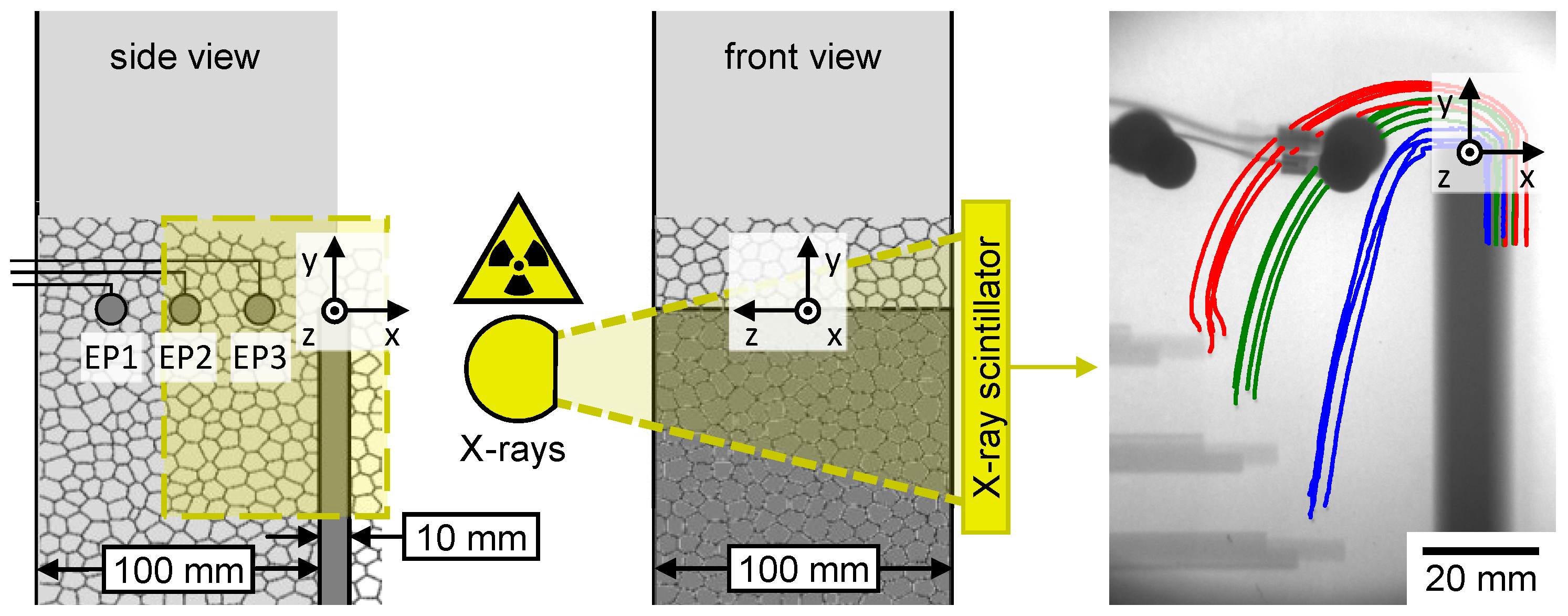



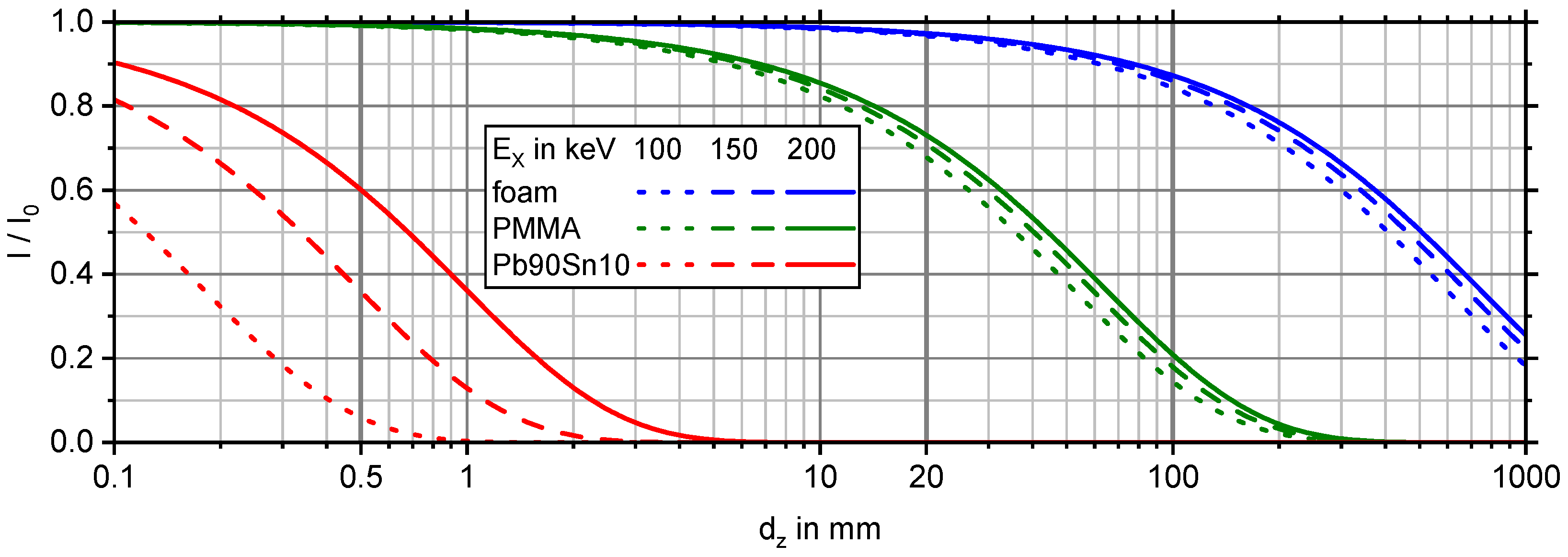
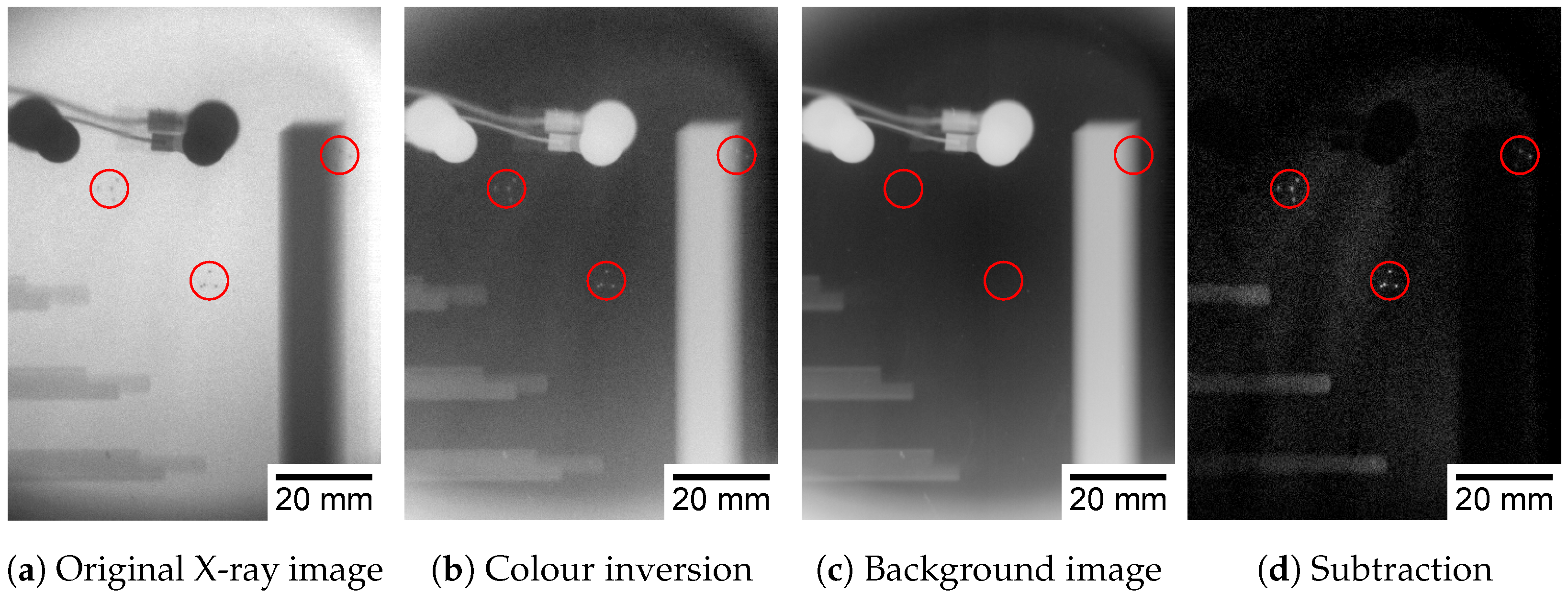
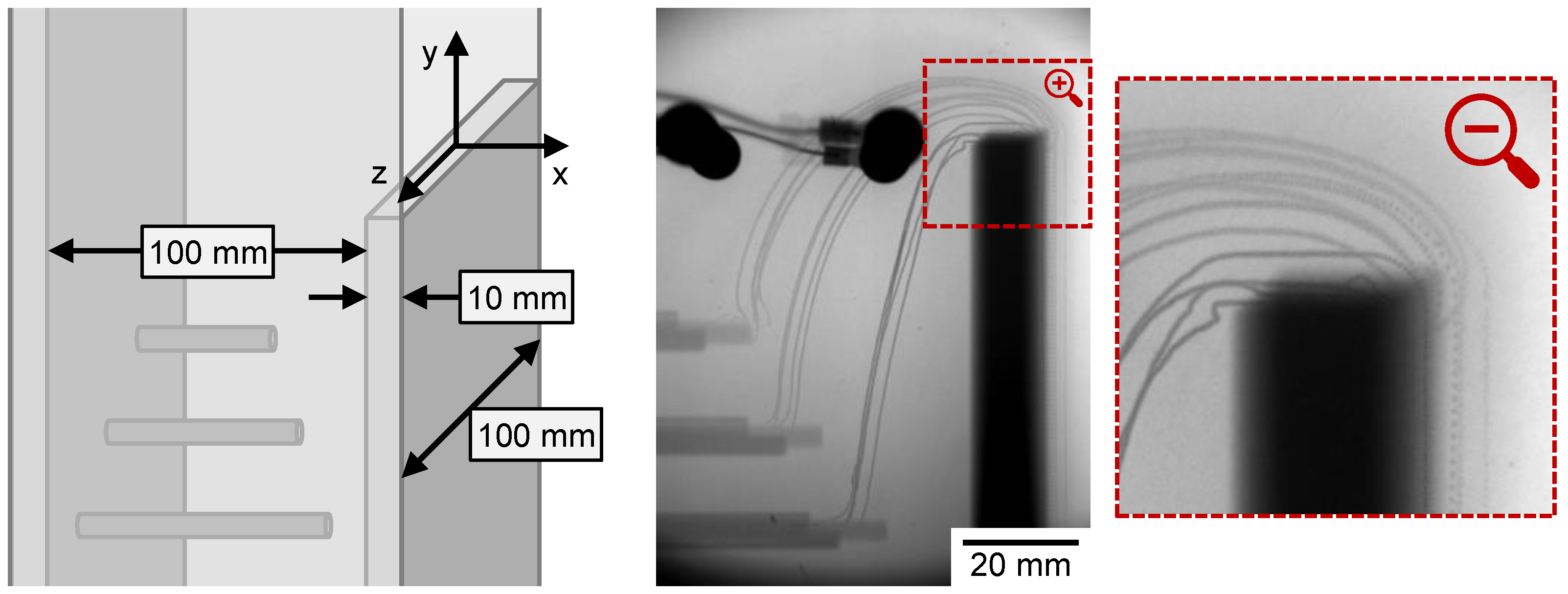

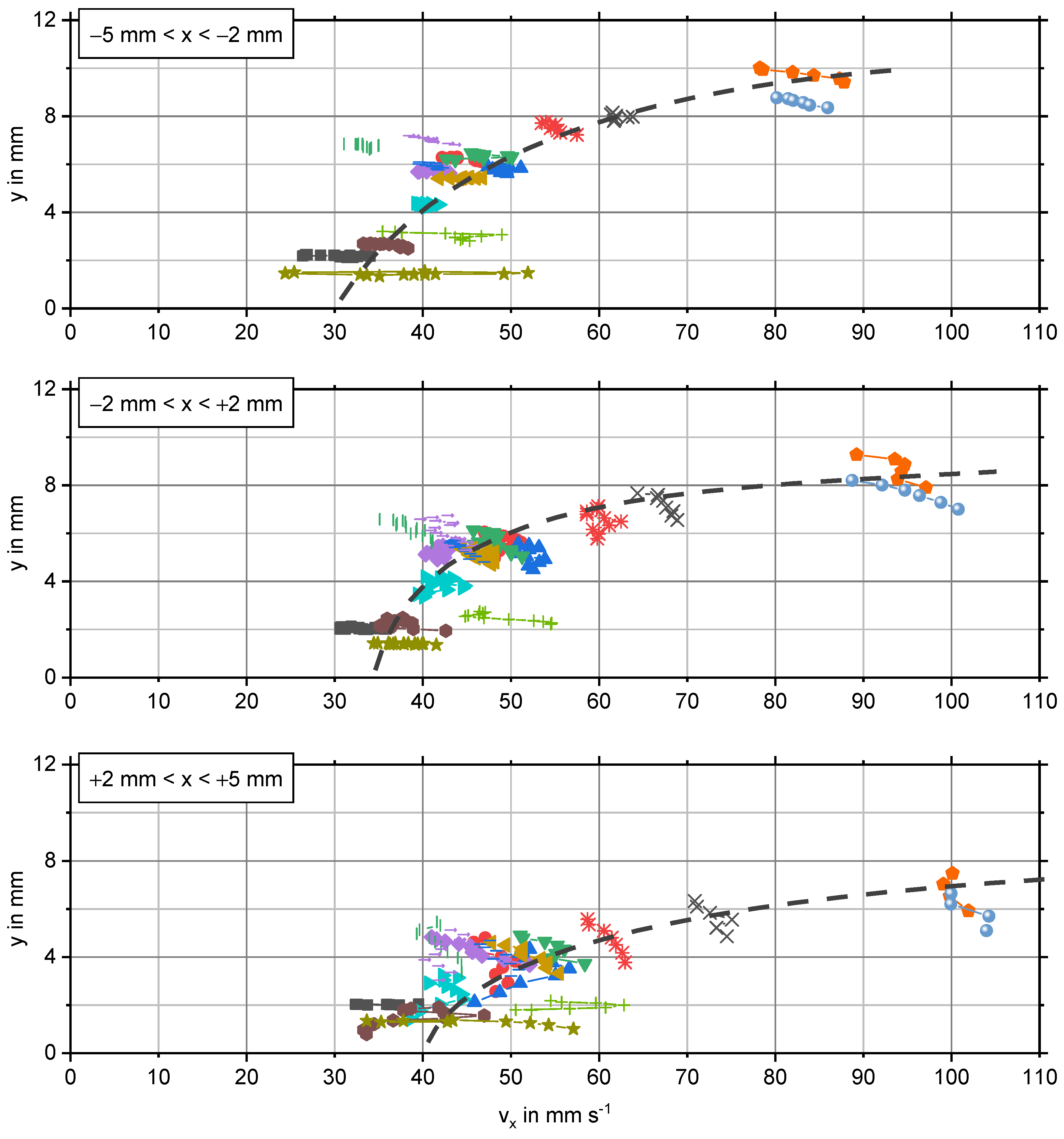

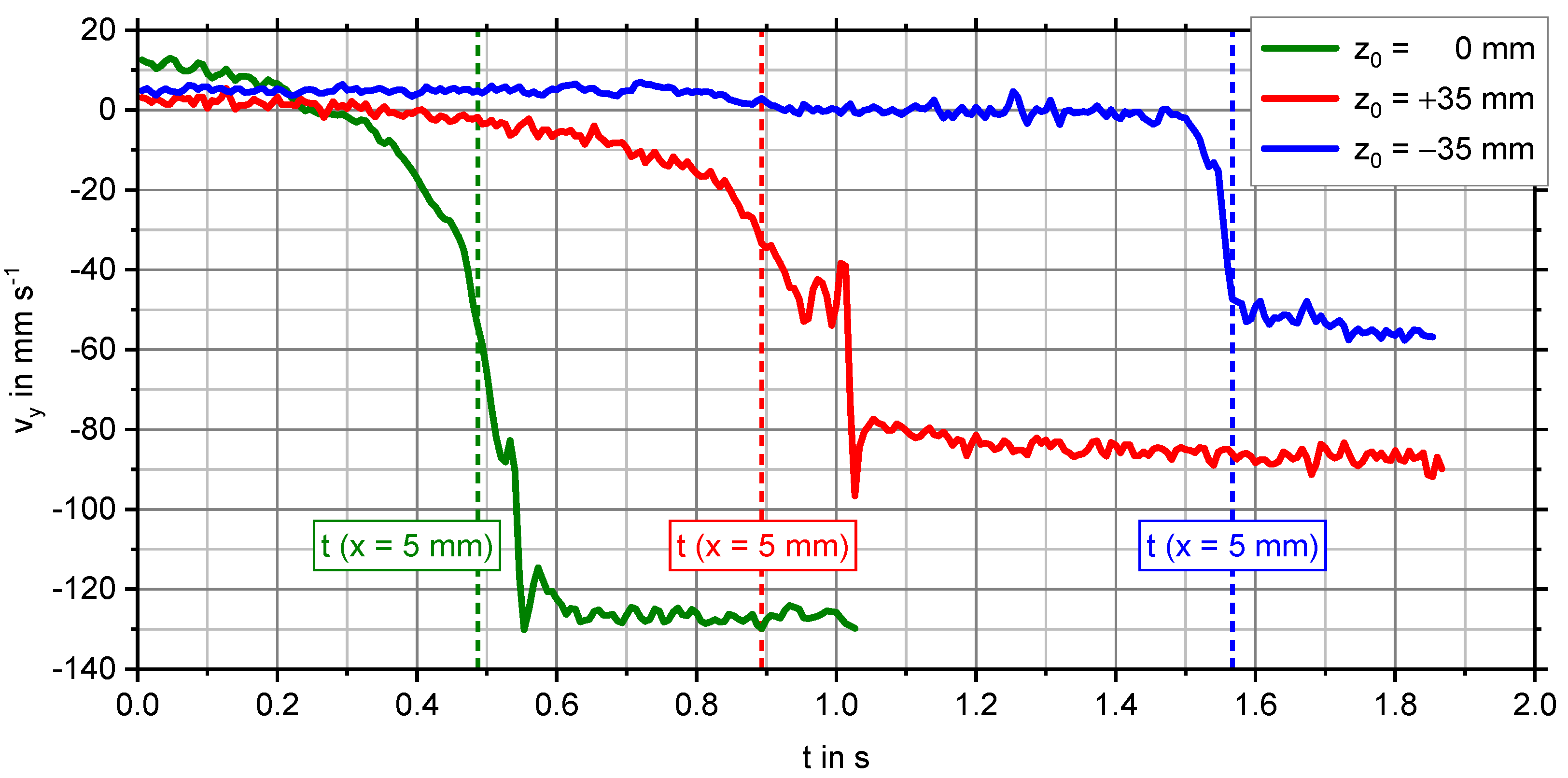
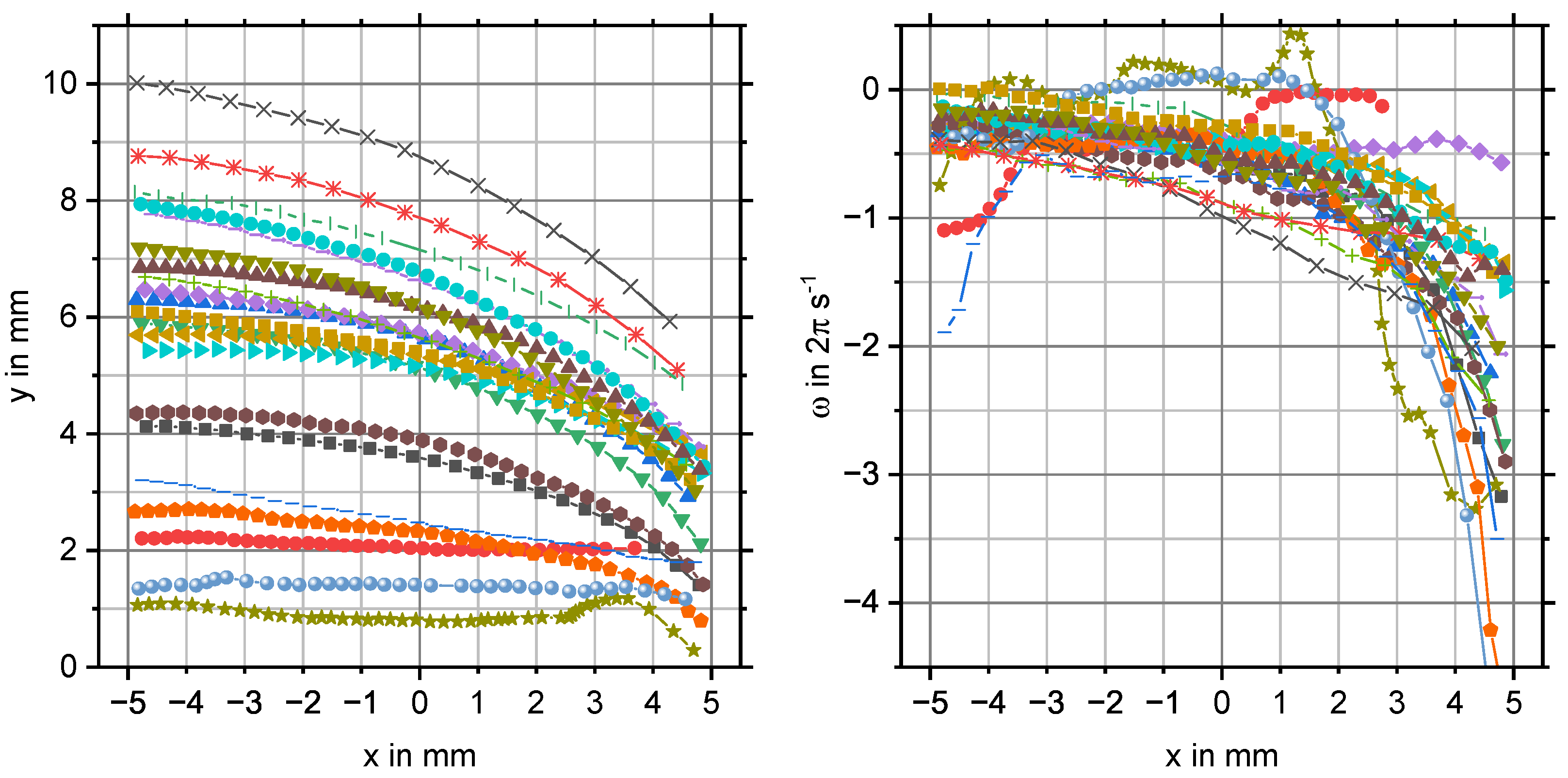
| i | |||
|---|---|---|---|
| 1 | 0.43 | ||
| 2 | 0.22 |
| Combination No. | 1 | 2 | 3 | 4 |
|---|---|---|---|---|
| polymer tetrahedron: edge length | 4 | 2 | 4 | 2 |
| metal beads: diameter | ||||
| tracer particle: weight-to-area ratio | 14 | 21 | 11 | 9 |
Disclaimer/Publisher’s Note: The statements, opinions and data contained in all publications are solely those of the individual author(s) and contributor(s) and not of MDPI and/or the editor(s). MDPI and/or the editor(s) disclaim responsibility for any injury to people or property resulting from any ideas, methods, instructions or products referred to in the content. |
© 2023 by the authors. Licensee MDPI, Basel, Switzerland. This article is an open access article distributed under the terms and conditions of the Creative Commons Attribution (CC BY) license (https://creativecommons.org/licenses/by/4.0/).
Share and Cite
Lappan, T.; Herting, D.; Ziauddin, M.; Stenzel, J.; Shevchenko, N.; Eckert, S.; Eckert, K.; Heitkam, S. X-ray Particle Tracking Velocimetry in an Overflowing Foam. Appl. Sci. 2023, 13, 1765. https://doi.org/10.3390/app13031765
Lappan T, Herting D, Ziauddin M, Stenzel J, Shevchenko N, Eckert S, Eckert K, Heitkam S. X-ray Particle Tracking Velocimetry in an Overflowing Foam. Applied Sciences. 2023; 13(3):1765. https://doi.org/10.3390/app13031765
Chicago/Turabian StyleLappan, Tobias, Dominic Herting, Muhammad Ziauddin, Julian Stenzel, Natalia Shevchenko, Sven Eckert, Kerstin Eckert, and Sascha Heitkam. 2023. "X-ray Particle Tracking Velocimetry in an Overflowing Foam" Applied Sciences 13, no. 3: 1765. https://doi.org/10.3390/app13031765







